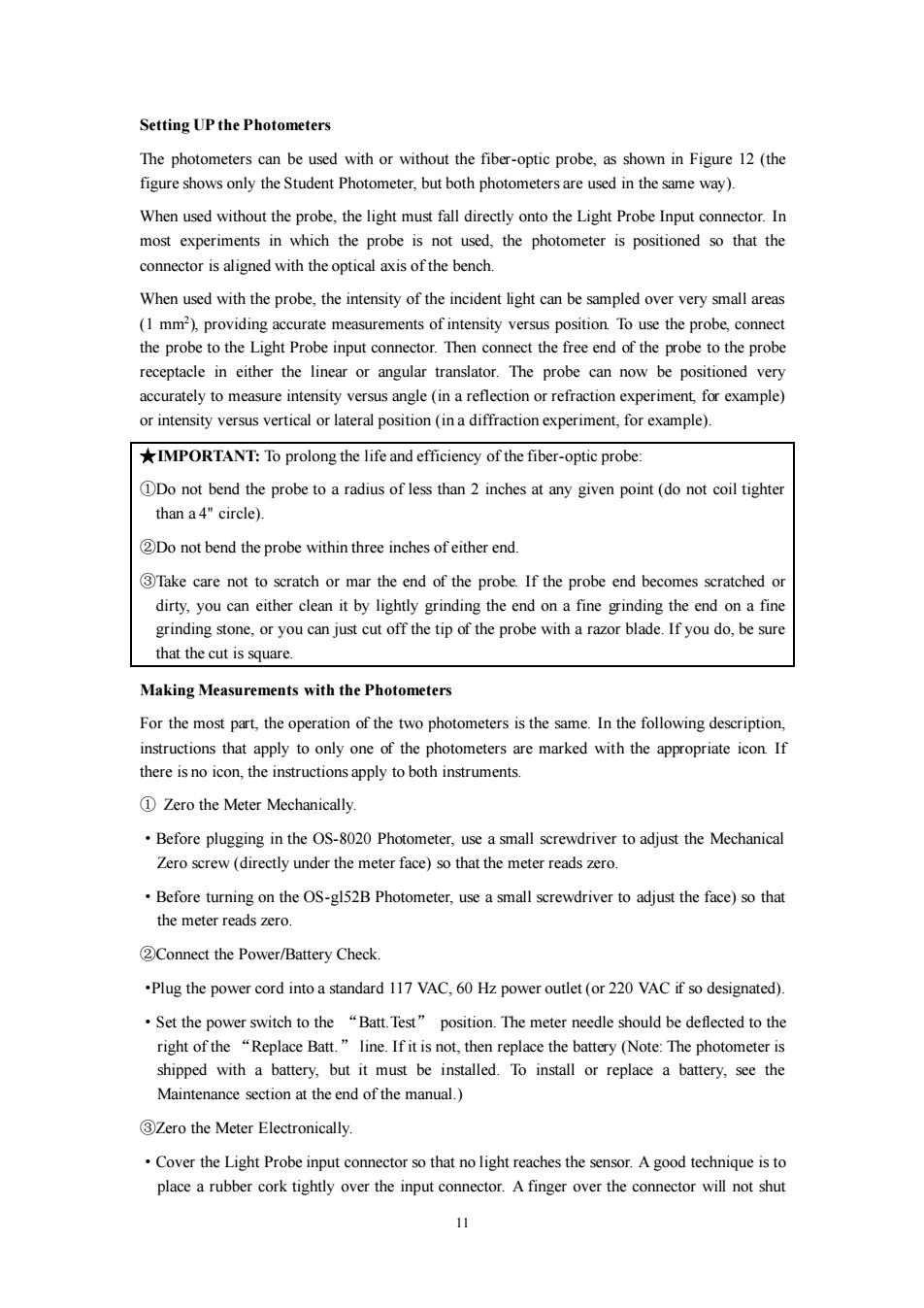正在加载图片...

Setting UP the Photometers The photometers can be used with or without the fiber-optic probe,as shown in Figure 12 (the figure shows only the Student Photometer,but both photometers are used in the same way). When used without the probe,the light must fall directly onto the Light Probe Input connector.In most experiments in which the probe is not used,the photometer is positioned so that the connector is aligned with the optical axis of the bench. When used with the probe,the intensity of the incident light can be sampled over very small areas (1 mm2),providing accurate measurements of intensity versus position.To use the probe,connect the probe to the Light Probe input connector.Then connect the free end of the probe to the probe receptacle in either the linear or angular translator.The probe can now be positioned very accurately to measure intensity versus angle(in a reflection or refraction experiment,for example) or intensity versus vertical or lateral position(in a diffraction experiment,for example). *IMPORTANT:To prolong the life and efficiency of the fiber-optic probe: DDo not bend the probe to a radius of less than 2 inches at any given point(do not coil tighter than a 4"circle). 2Do not bend the probe within three inches of either end. 3Take care not to scratch or mar the end of the probe.If the probe end becomes scratched or dirty,you can either clean it by lightly grinding the end on a fine grinding the end on a fine grinding stone,or you can just cut off the tip of the probe with a razor blade.If you do,be sure that the cut is square. Making Measurements with the Photometers For the most part,the operation of the two photometers is the same.In the following description, instructions that apply to only one of the photometers are marked with the appropriate icon If there is no icon,the instructions apply to both instruments. 1 Zero the Meter Mechanically. Before plugging in the OS-8020 Photometer,use a small screwdriver to adjust the Mechanical Zero screw(directly under the meter face)so that the meter reads zero. Before turning on the OS-gl52B Photometer,use a small screwdriver to adjust the face)so that the meter reads zero. 2Connect the Power/Battery Check. .Plug the power cord into a standard 117 VAC,60 Hz power outlet (or 220 VAC if so designated). .Set the power switch to the "Batt.Test"position.The meter needle should be deflected to the right of the "Replace Batt."line.If it is not,then replace the battery (Note:The photometer is shipped with a battery,but it must be installed.To install or replace a battery,see the Maintenance section at the end of the manual.) 3Zero the Meter Electronically. Cover the Light Probe input connector so that no light reaches the sensor.A good technique is to place a rubber cork tightly over the input connector.A finger over the connector will not shut W11 Setting UP the Photometers The photometers can be used with or without the fiber-optic probe, as shown in Figure 12 (the figure shows only the Student Photometer, but both photometers are used in the same way). When used without the probe, the light must fall directly onto the Light Probe Input connector. In most experiments in which the probe is not used, the photometer is positioned so that the connector is aligned with the optical axis of the bench. When used with the probe, the intensity of the incident light can be sampled over very small areas (1 mm2 ), providing accurate measurements of intensity versus position. To use the probe, connect the probe to the Light Probe input connector. Then connect the free end of the probe to the probe receptacle in either the linear or angular translator. The probe can now be positioned very accurately to measure intensity versus angle (in a reflection or refraction experiment, for example) or intensity versus vertical or lateral position (in a diffraction experiment, for example). ★IMPORTANT: To prolong the life and efficiency of the fiber-optic probe: ①Do not bend the probe to a radius of less than 2 inches at any given point (do not coil tighter than a 4" circle). ②Do not bend the probe within three inches of either end. ③Take care not to scratch or mar the end of the probe. If the probe end becomes scratched or dirty, you can either clean it by lightly grinding the end on a fine grinding the end on a fine grinding stone, or you can just cut off the tip of the probe with a razor blade. If you do, be sure that the cut is square. Making Measurements with the Photometers For the most part, the operation of the two photometers is the same. In the following description, instructions that apply to only one of the photometers are marked with the appropriate icon. If there is no icon, the instructions apply to both instruments. ① Zero the Meter Mechanically. ·Before plugging in the OS-8020 Photometer, use a small screwdriver to adjust the Mechanical Zero screw (directly under the meter face) so that the meter reads zero. ·Before turning on the OS-gl52B Photometer, use a small screwdriver to adjust the face) so that the meter reads zero. ②Connect the Power/Battery Check. ·Plug the power cord into a standard 117 VAC, 60 Hz power outlet (or 220 VAC if so designated). ·Set the power switch to the “Batt.Test” position. The meter needle should be deflected to the right of the “Replace Batt.” line. If it is not, then replace the battery (Note: The photometer is shipped with a battery, but it must be installed. To install or replace a battery, see the Maintenance section at the end of the manual.) ③Zero the Meter Electronically. ·Cover the Light Probe input connector so that no light reaches the sensor. A good technique is to place a rubber cork tightly over the input connector. A finger over the connector will not shut